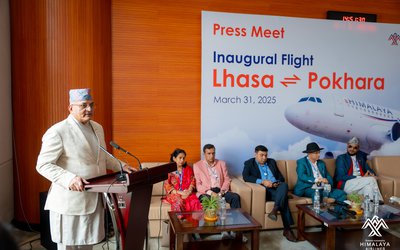More on Tourism





I’m one of few foreigners in Lumbini that are not from India, and as usual the locals help me find my way when I am unsure of the right path. People stop to ask me where I am from, am I Buddhist, and there is the customary surprise that I am travelling alone. It is, of course, “Visit Lumbini Year”, and one can only guess what the future holds for this pilgrimage destination that is attracting more and more visitors each year, and from far further abroad then India.
As a tourist from neither Nepal nor India, the trip from Kathmandu is not too difficult to undertake, but the roads along the mountainous way are precariously bumpy in places. Once at the entrance to the gardens and temple area itself, there are a few maps on signs at some intersections, but the tourist office is unmanned, and there are no personnel around to offer maps or information. Travellers with limited background knowledge on Buddhism or Buddha himself might find themselves at a loss for information without prior study or their ever-ready smart phones at hand.
The town of Lumbini, as well as the garden and grounds of the many monasteries here is a hive of activity. Small construction work is being done along the main tourist paths, many new temples and centres are being erected within the park itself, and there are many guesthouses and hotels being built or renovated to cater for the hordes of pilgrims that have visited this year, and the imminent increase of visitors in the future. The manager of my hotel tells me that every day there is a new hotel being built, and that this year has brought a significantly larger amount of visitors than previous years.
The Mayadevi temple – the main attraction as it stands above the place of Buddha Sakyamuni’s birth, and next to the Asoka pillar erected centuries ago – is a well maintained, impressive construction, standing within beautiful grounds. Tourists can meander along the path that takes them in and out of the temple and past the pillar, or leave it to explore the grassed and treed area to reflect and contemplate their sacred surroundings.
I am impressed by the Mayadevi temple’s construction when I enter because I was not aware beforehand that the white building actually is a protectorate building, sheltering the remains of the temple that existed there two millennia ago. A similar architectural concept can be seen in the New Acropolis Museum in Athens, Greece, where the museum was built over an archeological site that has continued to be excavated whilst being viewed by museum goers through the glass floor of the museum. It is a living museum, and history buffs can watch artifacts and foundations of buildings appear beneath their feet over time as they are unearthed. It is refreshing to see the stunning white Mayadevi temple from the outside, and step inside to see the foundations of what was once there, unspoilt, unrestored, but intact enough to give one the idea of the building that once stood.
Similarly the grounds around the temple hold a menagerie of foundation stones and parts of walls and original Stupas that were built anywhere from the Third Century BCE to the Eighth Century CE. After a visit to the Mayadevi temple, there is the long walk, or cycle around to the many different monasteries, temples and monuments that sit surrounding the long stretching pond in between the East and West sides of the park, culminating in the magnificent Japanese Peace Pagoda at its end.
With the signing of the agreement by the leader of the Unified Communist Party for Nepal-Maoists (UCPN-M), Prachanda, with a Chinese NGO for $3 Billion further development of Lumbini, what is in store for this little town with one big religious draw card? The controversial decision, which bypassed the Nepali government and is claimed to have been supported by the United Nations, has not been allocated a time-frame and details are at this stage unclear. The dream of Prachandaand the Chinese group is to create, with the help of India and Nepal, a “Mecca for Buddhists”, but his motivations and the motivations of China have been questioned as a ploy to feign close ties with the Tibetan community and edify mainly Chinese Buddhists by providing impeccable transport and accommodation options at the birthplace of Buddha.
The proposal by the Maoist leader has left many Nepali angry, and some Lumbini locals concerned about the commercialisation of their tiny town, which is surrounded by hay fields and plains. Buddhists are understandably sceptical of their sacred place being controlled by a Maoist leader, with the pain of the ongoing plight of Tibetans lying not far below the surface. The ministers that were kept in the dark regarding the decision have been left irate and one can only wonder whether co-operation between Prachanda and the Nepali government ministers would be possible, considering the sourness of their exclusion from the initial discussion.
And so what will the future hold for Lumbini, with its dusty streets and unmade roads? It certainly has the potential to be a magical place, to be enjoyed by all Buddhists of the world. The people will most likely keep coming, so development may be a necessary thing regardless of how it occurs. But a lot of money and development is needed to turn it into a Mecca for Buddhists – to tidy up the jungle- like gardens, add signs, make maps and proper information available, and provide easy and accessible transport for visitors, keeping in mind that many may not speak Nepali. Only time will tell if Prachanda’s dream is allowed to reach fruition, and if it is not, then hopefully the Nepali government – and the groups that have their temples and meditation centres erected there – will see the benefits of improving this sacred site of Lumbini, and will make decisions unanimously within a stable political climate to allow Lumbini to return to the Eden-like place it was in the time when Prince Siddhartha walked the Earth.




